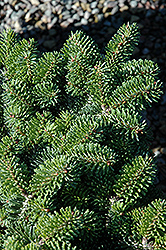Fri & Sat 8am - 8pm
Sun 8am - 7pm
Anytown, USA 12345
fax: 261.787.0463
e-mail: info@successgc.com


Plant Finder

Starker's Dwarf Korean Fir
Abies koreana 'Starker's Dwarf'
Height: 3 feet
Spread: 30 inches
Sunlight:
![]()
![]()
Hardiness Zone: 4b
Description:
A dwarf mounding fir with lovely textured needles displaying white undersides; loose spreading nest-like growth; protect from hot, direct sunlight
Ornamental Features
Starker's Dwarf Korean Fir is a dwarf conifer which is primarily valued in the garden for its interestingly mounded form. It has attractive forest green foliage with white undersides. The small needles are highly ornamental and remain forest green throughout the winter.
Landscape Attributes
Starker's Dwarf Korean Fir is a dense multi-stemmed evergreen shrub with a mounded form. Its relatively fine texture sets it apart from other landscape plants with less refined foliage.
This is a relatively low maintenance shrub, and usually looks its best without pruning, although it will tolerate pruning. It has no significant negative characteristics.
Starker's Dwarf Korean Fir is recommended for the following landscape applications;
- Mass Planting
- Rock/Alpine Gardens
- General Garden Use
Planting & Growing
Starker's Dwarf Korean Fir will grow to be about 3 feet tall at maturity, with a spread of 30 inches. It tends to fill out right to the ground and therefore doesn't necessarily require facer plants in front. It grows at a slow rate, and under ideal conditions can be expected to live for 60 years or more.
This shrub does best in full sun to partial shade. It requires an evenly moist well-drained soil for optimal growth. It is not particular as to soil pH, but grows best in sandy soils. It is quite intolerant of urban pollution, therefore inner city or urban streetside plantings are best avoided, and will benefit from being planted in a relatively sheltered location. Consider applying a thick mulch around the root zone in winter to protect it in exposed locations or colder microclimates. This is a selected variety of a species not originally from North America.
